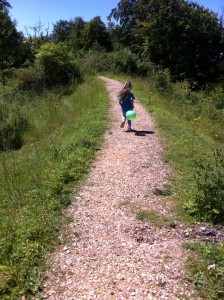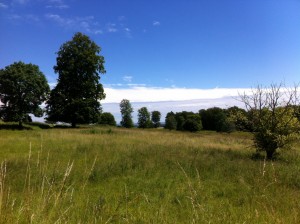Another day and it must be another child’s event at a school, a church or somewhere else. These last few weeks of school seem to be more manic than usual, but that could be to do with having a year 6 child with the end of primary school coming up (a bigger milestone for me or him?) and now having the Littlest at nursery. Anyway, today I find myself with her in the midst of the Hampshire downs at Danebury Hill fort.
We park in the top car park and walk up the path through the open grassland before coming to the ring of earthwork ramparts and the gap in them where the gate into the community would once have stood. As we walk up the steps that have been built to protect the earthworks from erosion, you can understand why this position was chosen to build a community and why it was occupied for almost 500 years. The fort was built in the Iron Age, 2,500 years ago, between the Bronze Age and the start of the Roman period. With its position standing high above the surrounding land, the vista is far reaching and any marauding hoards would have been seen well before they reached the fort! The name Danebury comes from the Old English ‘dun’ meaning hill and ‘bury’ meaning camp.

We soon find the nursery group walking across the flat, protected area of the fort and we catch them up. Walking into a small copse of trees, a den has been found for the children to ‘help’ finish building before sitting in it to sing songs and then have their picnic lunch. The day is balmy with sunshine and the occasional cotton wool cloud. Balloons are used to decorate the den and short pieces of rope are tied around branches for swinging on.

As the picnic finishes, the Littlest decided to lead our way away from the group along the top of the rampart again showing what an amazing vantage point the communities centuries ago must have had. Our return walk to the car could not be further from Danebury’s somewhat grisly past as shown on the BBC’s A History of Ancient Britain which showed some of the skulls excavated at the fort with horrific wounds, probably from ‘gruesome and

violent tribal battles’. In one excavation a pit with 11,000 slingshot stones was found; that would do some serious damage. Evidence has also been found of 73 roundhouses, 500 rectangular buildings and thousands of deep storage pits within the confines of the fort. The fabulous Museum of the Iron Age in Andover has a wealth of information on Danebury including reconstructions and exhibits of some of the finds – definitely worth a visit, even for the Littlest.

Our walk through the chalk grassland is peaceful and the noisiest event is the Littlest chasing butterflies down the hill. The area is protected and a Site of Special Scientific Interest and I realise yet again how incredibly fortunate we are having such extraordinarily beautiful countryside on our doorstep. I promise myself to visit with the rest of the Tribe more frequently.
www.hants3.gov.uk/countryside/danebury
www.hants3.gov.uk/andover-museum
www.abbottsannnursey.co.uk




